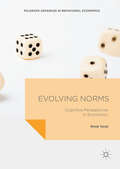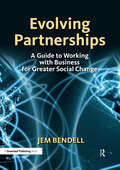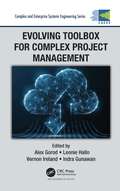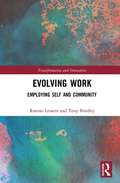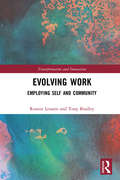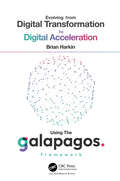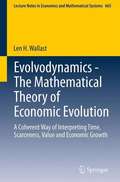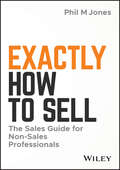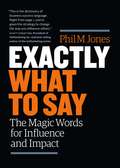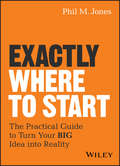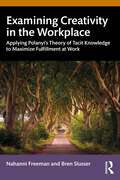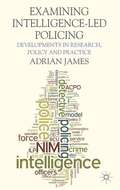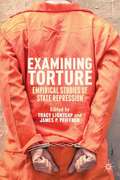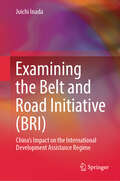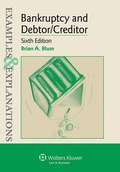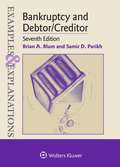- Table View
- List View
Evolving Norms
by Shinji TerajiThis book presents institutional evolution and individual choice as codependent results of behavioral patterns. Drawing on F. A. Hayek's concepts of cognition and cultural evolution, Teraji demonstrates how the relationship between the sensory and social orders can allow economists to track social norms and their effects on the global economy. He redirects attention from the conventional focus on what an individual chooses to the changing social order that determines how an individual chooses. Cultural shifts provide the environmental feedback that challenges the mental models governing individual choice, creating a cycle of coevolution. Teraji develops a general framework from which to examine this symbiotic relationship in order to identify predictive patterns. Not just for behavioral economists, this book will also appeal to those who specialize in institutional economics, the philosophy of economics, and economic sociology.
Evolving Partnerships: A Guide to Working with Business for Greater Social Change
by Jem BendellBy bringing together their respective competencies and resources for the greater good, governments, business, civil society and multilateral agencies have been seeking innovative ways to work together to respond to the myriad global challenges of our time: the impact of climate change; human security; the prevention, care and treatment of HIV/AIDS and other major diseases; the generation of new investment, entrepreneurship and employment; and financing for development. The appetite for such partnerships appears strong. Over 90% of corporate executives responding to a World Economic Forum survey felt that future partnerships between business, government and civil society would play either a major role or some role in addressing key development challenges. This trend will only be increased by the Western financial crisis and the retreat of the state from many areas of societal concern. In the last 15 years, many new partnerships have been formed, and many new people exposed to partnership ways of working. There have been remarkable successes, but also a range of concerns about effectiveness and accountability. Partnerships can work, but can they work better? Many practitioners are now asking how they can achieve a greater scale of impact to match the magnitude of the social and environmental challenges we face. When considering how to equip their organization or programme with the necessary skills to engage with companies in new ways, many leaders of NGOs or UN agencies hire staff from the private sector. Although such staff exchanges are important, it is not sufficient to rely on private-sector staff to develop and implement strategic forms of engagement. Rather, engaging business for social change is a specialism in itself. This book seeks to distil some of the author's 15 years of experience and key learnings on the advanced strategic planning of partnerships for people who work within civil society or public-sector organizations and who already partner with companies. Much of the research focus to date has been on operational issues, rather than on the strategic challenge of evolving partnerships to achieve a greater scale of impact. Rather than helping the reader with moving on from partnerships, this guidebook is intended to help with moving up to a greater scale of impact. The author identifies three generations in the evolution of cross-sector partnering and draws insights from the latest biological evolutionary theory on how complex systems can sustain themselves over time, translating this into a method for understanding and assessing partnering practice. Evolving Partnerships provides a rich and accessible mix of commentary, boxes for clarification, and 11 exercises to help the reader evolve partnering to achieve a wider level of impact – a level that responds to the scale, depth and urgency of the challenges we face today. Written by one of the world's leading authorities on partnerships and a key architect of global partnerships, including the Marine Stewardship Council, Evolving Partnerships will be essential reading for all those involved in cross-sectoral partnerships.
Evolving Toolbox for Complex Project Management (Complex and Enterprise Systems Engineering)
by Indra Gunawan Alex Gorod Vernon Ireland Leonie HalloThis book enhances learning about complex project management principles and practices through the introduction and discussion of a portfolio of tools presented as an evolving toolbox. Throughout the book, industry practitioners examine the toolsets that are part of the toolbox to develop a broader understanding of complex project management challenges and the available tools to address them. This approach establishes a dynamic, structured platform for a comprehensive analysis and assessment of the modern, rapidly changing, multifaceted business environment to teach the next generation of project managers to successfully cope with the ever increasing complexity of the 21st century.
Evolving Trends in Global Trade
by Annelena Lobb Dante RosciniThe note, while not intended to be historically comprehensive, explores the regulation of international trade from the period after World War II to developments in 2010, focusing on shifts in trade theory and policy as well as economic benefits and disadvantages associated with trade liberalization. The note also discusses the advantages and disadvantages of multilateral vs. bilateral or plurilateral agreements, as the latter become more common in arrangements between trading partners.
Evolving Work: Employing Self and Community
by Ronnie Lessem Tony Bradley<p>The idea of Self and the authenticity of particular identities have been rapidly dissolving in the acids of post-modern globalising capitalism. The hegemony of patterns of work, wage-labor and the operation of labour markets in the American West (and European North) has ridden rough-shod over distinctive ways of enabling communities to flourish in many parts of the Southern and Eastern worlds (Global South). But, this is not inevitable. Indeed, as this book indicates, there are many practical examples across the globe – that connect with some of the most significant theoretical challenges to the operation of dehumanising work – which reveal that a profound reversal is taking place. As such, the core theme of this book is to show that a movement is occurring whereby self-employment can be transformed into communal work that employs the Self in ways that release the authentic vocations of people, individually and collectively. <p>The approach taken in these chapters traverses the globe, utilising the original ‘integral worlds’ model that will be familiar to students of the Trans4M/Routledge Transformation and Innovation series, developed over more than a decade. Such a standpoint points the way to the release of particular social and economic cultures in each of what we term the four "realities" or "worldviews" of South, East, North and Western worlds. In this book we use the methodology of GENEalogy – identifying the realms associated with each world – to show how the rhythms, that is Grounding, Emergence, Navigation and Effect, of each is leading to greater economic, social and spiritual freedom for individuals, organisations, communities and, indeed, entire societies.</p>
Evolving Work: Employing Self and Community (Transformation and Innovation)
by Ronnie Lessem Tony BradleyThe idea of Self and the authenticity of particular identities have been rapidly dissolving in the acids of post-modern globalising capitalism. The hegemony of patterns of work, wage-labor and the operation of labour markets in the American West (and European North) has ridden rough-shod over distinctive ways of enabling communities to flourish in many parts of the Southern and Eastern worlds (Global South). But, this is not inevitable. Indeed, as this book indicates, there are many practical examples across the globe – that connect with some of the most significant theoretical challenges to the operation of dehumanising work – which reveal that a profound reversal is taking place. As such, the core theme of this book is to show that a movement is occurring whereby self-employment can be transformed into communal work that employs the Self in ways that release the authentic vocations of people, individually and collectively. The approach taken in these chapters traverses the globe, utilising the original ‘integral worlds’ model that will be familiar to students of the Trans4M/Routledge Transformation and Innovation series, developed over more than a decade. Such a standpoint points the way to the release of particular social and economic cultures in each of what we term the four "realities" or "worldviews" of South, East, North and Western worlds. In this book we use the methodology of GENEalogy – identifying the realms associated with each world – to show how the rhythms, that is Grounding, Emergence, Navigation and Effect, of each is leading to greater economic, social and spiritual freedom for individuals, organisations, communities and, indeed, entire societies.
Evolving from Digital Transformation to Digital Acceleration Using The Galapagos Framework
by Brian HarkinEvolving from Digital Transformation to Digital Acceleration Using The Galapagos Framework challenges established thinking and offers a new way to deliver digital change. It introduces The Galapagos Framework, which is a new, innovative, and human-centric approach to transformational change. The framework allows organizations to move from digital transformation to digital acceleration, resulting in the creation of exciting and groundbreaking products as well as having a positive impact on the motivation and well-being of their teams.Digital Acceleration is an iterative process that allows organizations to deliver transformations and demonstrate continual progress at pace. Rather than tackling the transformation as one large single event, Digital Acceleration enables organizations to improve one or, at most, two discrete areas of the business quickly and then move onto the next area needing improvement.Presenting a detailed guide to The Galapagos Framework, the book also highlights solutions to common issues, expert case studies, and The Galapagos Roadmap. It discusses how the framework provides the key to increasing productivity, delivery velocity, and performance while reducing cost and complexity, ultimately resulting in digital and business success. The book demonstrates how The Galapagos Framework operates in practice to provide clear solutions to common issues that are classifi ed into Human Elements, Organizational Factors, and the Delivery Aspects. The book also explains why the current approaches to digital transformation are failing and shows how digital leaders and organizations can: Increase productivity Reduce costs Improve delivery performance Reduce operational, financial, and delivery risks Increase profits Deliver digital transformation success
Evolving the Management System for Data and Information: Ten Simple Steps
by Thomas C. RedmanIn time, more and more organizations will evolve their management systems to better utilize data and information, improve their quality, and account for the special challenges in managing them. To help facilitate this evolution, the author offers ten specific steps that help organizations manage their data and information assets more professionally.
Evolvodynamics - The Mathematical Theory of Economic Evolution
by Len H. WallastDissatisfied with the flaws of orthodox economics, the author proposes to base economic theory on the three principles of Darwinian evolution (variation, inheritance, selection). Pursuing a suggestion of E.T. Jaynes of 1991, the innovation is in treating economic behavior as chance events of selection. This involves abandoning the methods of mainstream economics and to apply instead the methods by which Claude E. Shannon analyzed information transport over a stationary channel. As economic processes are non-stationary, the author clarifies first how the Shannon-system must be reshaped in a system capable to describe economic evolution mathematically. As economic processes are non-stationary, the author first clarifies how the Shannon system must be reshaped into one capable of describing economic evolutions mathematically. Deriving the universal relations between input, output, the economic growth rate, inflation and money flow involves applying differential sets of selection, Venn diagrams, bitpulses as units of selection and the probability distributions of bitpulses. This is a thought-provocative and highly informative book of which the explanatory power goes far beyond that of traditional economics. It should be on the readers list of everyone concerned with the weal and woe of economic theorizing.
Exactly How to Sell: The Sales Guide for Non-Sales Professionals
by Phil M. Jones<p>The sales guide for non-sales professionals <p><i>Exactly How to Sell</i> walks you through a tried and true process that draws on time tested methods that are designed to attract and keep more customers. No matter what you are selling (yourself, your product or your services) this simple read is certain to provide you actionable strategies to deliver you more of the sales results you are looking for. <p>Inside, Phil M. Jones writes from experience and explains how to get more customers and keep them all happy—while they’re spending more money, more often. Using simple, practical, and easy-to-implement methods in line with the modern business landscape, Phil educates and guides you, giving you the confidence you need to develop the skills you need to win more business. <p> <li>Boost your salesmanship to support your core profession <li>Create intent in a buyer and scenarios where everybody wins <li>Choose your words wisely and present like a pro <li>Overcome the indecision in your customers and close more sales <li>Manage your customer base and have them coming back for more</li> <p> <p>If you want to up your sales game, <i>Exactly How to Sell</i> shows you how.</p>
Exactly What to Say: The Magic Words for Influence and Impact
by Phil JonesOften the decision between a customer choosing you over someone like you is your ability to know exactly what to say, when to say it, and how to make it count. Phil M. Jones has trained more than two million people across five continents and over fifty countries in the lost art of spoken communication. In Exactly What to Say, he delivers the tactics you need to get more of what you want.
Exactly Where to Start: The Practical Guide to Turn Your BIG Idea into Reality
by Phil M. JonesGet out of your own way and bring your ideas to life! Exactly Where to Start is a playbook for everyone with a great idea, everyone with a goal in mind, and everyone with a specific destination but no journey. We’ve been told all our lives that “good things come to those who wait”—but that’s a myth. Good things come to those who do. Too often, we get stuck in the “getting ready” stage: research, analysis, brainstorming, and more research; we feel like we need to know everything there is to know about what we want to do before we ever take the first steps. Meanwhile, the people who actually go out and do the thing are taking risks, learning lessons, and making strides toward their goals every single day. Isn’t it time you joined them? This book coaches you through the journey with precise, actionable steps that help you take that all-important first leap and keep the momentum going. Discard the distractions, break through the overwhelm, and get going for real with this real-world blueprint for turning your vision into reality. Snap yourself out of “analysis paralysis” Stop thinking you need to know everything before you even begin Make those big decisions and focus in on your goals Chart your journey’s path, and get up and get started today Many of us have fallen into a trap: we no longer believe that “anything is possible”, yet we are surrounded by proof that everything is possible! But we are distracted, harried, overwhelmed, and maybe a little intimidated. Our dreams remain forever in limbo, and we may go to our graves before we venture beyond the “planning stage”. Don’t let that happen—don’t you deserve to realize your goals? Exactly Where to Start gives you the kick in the pants and the practical plan you need to stand up, step up, and make it happen.
Examinatorium Privatversicherungsrecht: Über 850 Prüfungsfragen und 5 Klausurfälle (Springer-Lehrbuch)
by Christian ArmbrüsterDas Examinatorium umfasst über 850 Fragen und Antworten sowie fünf Klausurfälle mit Lösungshinweisen zum Privatversicherungsrecht. Der inhaltliche Schwerpunkt liegt auf dem Versicherungsvertragsrecht des VVG; einbezogen werden aber auch das Gleichbehandlungsrecht (AGG), das Versicherungsaufsichtsrecht, das Versicherungsunternehmensrecht sowie Fragen des internationalen Rechts (Kollisionsrecht, europäisches Versicherungsvertragsrecht). Das Werk ermöglicht insbesondere Studierenden, aber auch allen mit der Materie in der Praxis befassten Juristen, ihren Wissensstand zu überprüfen sowie zu erweitern.
Examinatorium Privatversicherungsrecht: Über 850 Prüfungsfragen und 5 Klausurfälle (Springer-Lehrbuch)
by Christian ArmbrüsterDas Examinatorium umfasst über 850 Fragen und Antworten sowie fünf Klausurfälle mit Lösungshinweisen zum Privatversicherungsrecht. Der inhaltliche Schwerpunkt liegt auf dem Versicherungsvertragsrecht des VVG; einbezogen werden aber auch das Gleichbehandlungsrecht (AGG), das Versicherungsaufsichtsrecht, das Versicherungsunternehmensrecht sowie Fragen des internationalen Rechts (Kollisionsrecht, europäisches Versicherungsvertragsrecht). Hinzu kommen aktuelle Entwicklungen wie Digitalisierung und Nachhaltigkeit im Versicherungssektor. Das Werk ermöglicht insbesondere Studierenden, aber auch allen mit der Materie in der Praxis befassten Juristen, ihren Wissensstand zu überprüfen sowie zu erweitern.
Examinatorium zum Gesellschaftsrecht: Klausuren und Prüfungsfragen für das Studium, den Schwerpunktbereich und die erste juristische Prüfung (Juristische ExamensKlausuren)
by Christian Armbrüster Lukas BöffelDas Examinatorium deckt das gesamte examensrelevante Spektrum zum Gesellschaftsrecht ab. Neben Personen- und Kapitalgesellschaftsrecht werden auch Grundzüge des Konzernrechts erfasst. Das Klausurentraining dient Studierenden und Examenskandidaten zur Wiederholung, Vertiefung und fallbezogenen Anwendung des Prüfungsstoffes. Die große Prüfungsrelevanz der Fälle und zahlreiche Hinweise zur Prüfungsvorbereitung erleichtern zudem die Umsetzung bereits erworbenen Basiswissens im Schwerpunkt und Examen. Die Neuauflage berücksichtigt bereits vollumfänglich die zahlreichen und prüfungsrelevanten Gesetzesänderungen im Personengesellschaftsrecht, die ab dem 1. Januar 2024 infolge des MoPeG gelten. Der Autor Armbrüster ist Inhaber eines Lehrstuhls für Gesellschaftsrecht an der Freien Universität Berlin und prüft seit Jahrzehnten regelmäßig im Schwerpunktbereich und mündlichen Examensprüfungen Gesellschaftsrecht ab. Der Autor Böffel hat an diesem Lehrstuhl als wiss. Mitarbeiter mehrere Jahre gearbeitet und während dieser Zeit schriftliche Schwerpunktleistungen im Gesellschaftsrecht als Gutachter bewertet. Beide Autoren sind daher mit den Anforderungen, die an Studierende und Examenskandidaten gestellt werden, bestens vertraut.
Examining Creativity in the Workplace: Applying Polanyi’s Theory of Tacit Knowledge to Maximize Fulfillment at Work
by Nahanni Freeman Bren SlusserThis scholarly book explores the intersection of social cognition with a democratic philosophy of human resource management to advance a theory of workplace function that maximizes creativity. It examines how the work of Polanyi on tacit knowledge provides a useful theoretical structure for understanding person perception and self‑fulfilling prophecy effects in the workplace, with a focus on gender, culture, and race as diversity variables. Based on a broad range of interdisciplinary empirical evidence and theories, this book provides a foundational set of concepts to build new applied intervention strategies. The authors create new, testable theories based on a synthesis of several major areas of research in social psychology and human resource management, moving beyond the narrow confines of trends in a particular subdomain. Part 1 offers a literature review of the field, ranging from theoretical, historical, and philosophical psychology to social psychology and neurocognition. Each chapter in this section offers a novel theory that is pertinent to workplace innovation, synthesized from existing evidence. Part 2 reveals applications of tacit knowledge to the field of human resource management, with a focus on cross‑cultural applications for low‑ and high‑power distance settings. This insightful text presents the authors’ original, qualitative research around workplace creativity and tacit knowledge and is valuable reading for scholars and advanced students in industrial‑organizational psychology and human resource management.
Examining Intelligence-Led Policing
by Adrian JamesForeword from Professor Emeritus Robert Reiner, London School of Economics, UK. This book provides a critical examination of intelligence-led policing strategies, including an investigation of innovative strategies such as Problem Oriented Policing (POP), problem-solving, and community policing, and in-depth analyses of the Kent Policing Model, which became the template for ILP models across the world, and the UK's National Intelligence Model (NIM). Intelligence-led policing (ILP) approaches have proved particularly attractive to senior police officers and policymakers because they promise to deliver more efficient and effective solutions to the problems of crime than traditional policing practices. However, this book shows that these approaches have delivered far less than their supporters would have us to believe. In part, this has been because of what James terms as 'police orthodoxy'. However, this cannot wholly explain the relative failure of ILP in Britain and elsewhere in the developed world. Drawing on a range of material including extensive interviews with key NIM figures including ACPO members, senior police managers, intelligence workers, police detectives and staff, James questions to what extent British policing can truly be said to be intelligence-led, and whether there is a popular mandate for an alternative to traditional Peelian practice, where police aim simply to deliver intelligent rather than intelligence-led policing. The book provides important insights into the debate on intelligence-led policing and the mechanics and politics of policy development. As such it will be of great value within the policing sphere and more broadly for public policy studies.
Examining Torture
by James P. Pfiffner Tracy LightcapThe United States' use of torture and harsh interrogation techniques during the "War on Terror" has sparked fervent debate among citizens and scholars surrounding the human rights of war criminals. Does all force qualify as "necessary and appropriate" in this period of political unrest? Examining Torture brings together some of the best recent scholarship on the incidence of torture in a comparative and international context. The contributors to this volume use both quantitative and qualitative studies to examine the causes and consequences of torture policies and the resulting public opinion. Policy makers as well as scholars and those concerned with human rights will find this collection invaluable.
Examining the Adoption of Drug-Eluting Stents
by Elie OfekMarketers are often tasked with exploring the factors that impact the long-run adoption of a new product or technology. The new product under consideration here is the drug-eluting stent: a device which props open a clogged artery to the heart and then releases medication that reduces the risk of artery re-blockage. In light of recent medical and competitive trends in the market, the case prompts students to examine the future adoption of drug-eluting stents as well as to consider the potential marketing actions to be taken by Medtronic for ENDEAVOR - a newly approved stent that will hit the market in 2008.
Examining the Belt and Road Initiative (BRI): China’s Impact on the International Development Assistance Regime
by Juichi InadaThis book endeavors to examine the impact of China's rapid ascendance as a donor on the "international development assistance regime" over the past two decades. China's rapid economic rise and the success of its economic development have led to a notable trend among many developing countries to view the way of China as a "Chinese development model” and to imitate it. In addition, China itself has been conscious of the "challenge" to the development theory and international development assistance regime that has been led mainly by the West and has pushed for policies that differ from those of traditional donors. The "Belt and Road Initiative (BRI)," which was announced in 2013, is emblematic of these distinctive developments in China. The proliferation of the "Chinese development model" in the context of these international trends has led some to view it as the global spread of the "Beijing Consensus," which has replaced the "Washington Consensus" led by the Bretton Woods Institutions that have exerted significant influence in the past. This book presents case studies of several countries, based on the author's field research in Cambodia, Sri Lanka, Myanmar, Angola, Rwanda, and other countries.
Examples & Explanations Federal Income Tax,Seventh Edition
by Katherine Pratt Thomas D. Griffith Joseph BankmanA favorite among successful students, and often recommended by professors, the unique Examples & Explanations series gives you extremely clear introductions to concepts followed by realistic examples that mirror those presented in the classroom throughout the semester. Use at the beginning and midway through the semester to deepen your understanding through clear explanations, corresponding hypothetical fact patterns, and analysis. Then use to study for finals by reviewing the hypotheticals as well as the structure and reasoning behind the accompanying analysis. Designed to complement your casebook, the trusted Examples & Explanations titles get right to the point in a conversational, often humorous style that helps you learn the material each step of the way and prepare for the exam at the end of the course.
Examples & Explanations: Bankruptcy & Debtor/Creditor Sixth Edition
by Brian A. BlumThis book offers basic overview of debt collection under state law and an introduction to concepts and principles that underlie both state debtor/creditor law and bankruptcy.
Examples And Explanations For Federal Income Tax (Examples And Explanations)
by Katherine Pratt Thomas D. Griffith Joseph BankmanA favorite classroom prep tool of successful students that is often recommended by professors, the Examples & Explanations (E&E) series provides an alternative perspective to help you understand your casebook and in-class lectures. Each E&E offers hypothetical questions complemented by detailed explanations that allow you to test your knowledge of the topics in your courses and compare your own analysis. Here’s why you need an E&E to help you study throughout the semester: Clear explanations of each class topic, in a conversational, funny style. Features hypotheticals similar to those presented in class, with corresponding analysis so you can use them during the semester to test your understanding, and again at exam time to help you review. It offers coverage that works with ALL the major casebooks, and suits any class on a given topic. The Examples & Explanations series has been ranked the most popular study aid among law students because it is equally as helpful from the first day of class through the final exam.
Examples and Explanations for Bankruptcy and Debtor/Creditor
by Brian A. Blum Samir D. ParikhA favorite among successful students, and often recommended by professors, the unique Examples & Explanations series gives you extremely clear introductions to concepts followed by realistic examples that mirror those presented in the classroom throughout the semester. Use at the beginning and midway through the semester to deepen your understanding through clear explanations, corresponding hypothetical fact patterns, and analysis. Then use to study for finals by reviewing the hypotheticals as well as the structure and reasoning behind the accompanying analysis. Designed to complement your casebook, the trusted Examples & Explanations titles get right to the point in a conversational, often humorous style that helps you learn the material each step of the way and prepare for the exam at the end of the course. <P><P> The unique, time-tested Examples & Explanations series is invaluable to teach yourself the subject from the first day of class until your last review before the final. Each guide: <P><P> helps you learn new material by working through chapters that explain each topic in simple languagechallenges your understanding with hypotheticals similar to those presented in class <P><P>provides valuable opportunity to study for the final by reviewing the hypotheticals as well as the structure and reasoning behind the corresponding analysis <P><P>quickly gets to the point in conversational style laced with humorremains a favorite among law school studentsis often recommended by professors who encourage the use of study guidesworks with ALL the major casebooks, suits any class on a given topic <P><P>provides an alternative perspective to help you understand your casebook and in-class lectures
Examples and Explanations: Wills, Trusts and Estates
by Gerry W. BeyerA favorite among successful students, and often recommended by professors, the unique Examples & Explanations series gives you extremely clear introductions to concepts followed by realistic examples that mirror those presented in the classroom throughout the semester. Use at the beginning and midway through the semester to deepen your understanding through clear explanations, corresponding hypothetical fact patterns, and analysis. Then use to study for finals by reviewing the hypotheticals as well as the structure and reasoning behind the accompanying analysis. Designed to complement your casebook, the trusted Examples & Explanations titles get right to the point in a conversational, often humorous style that helps you learn the material each step of the way and prepare for the exam at the end of the course.
